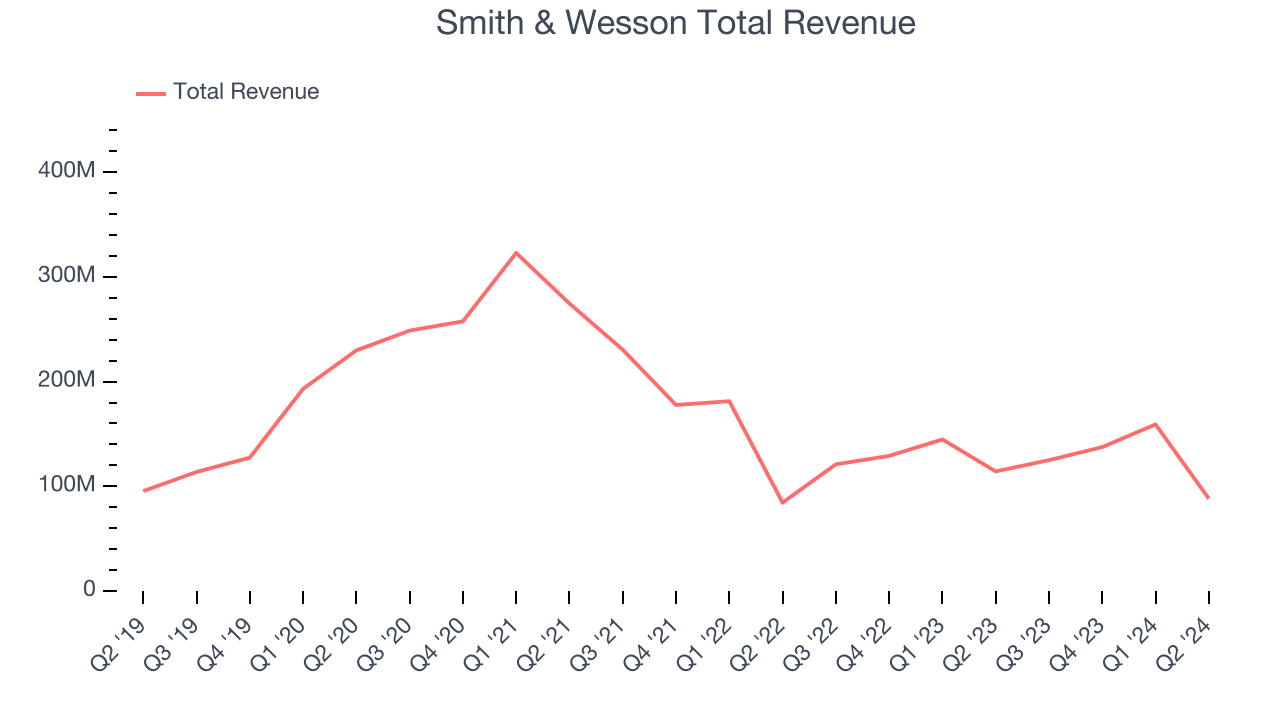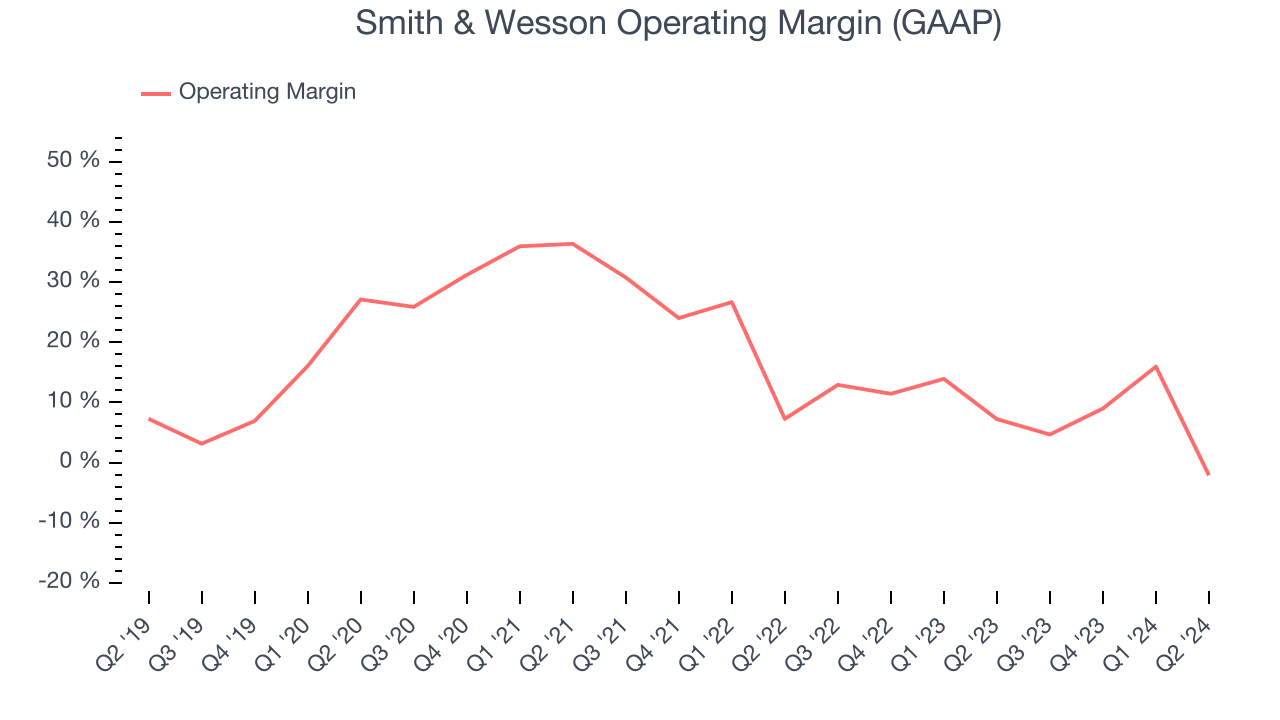American firearms manufacturer Smith & Wesson (NASDAQ:SWBI) missed analysts’ expectations in Q2 CY2024, with revenue down 22.7% year on year to $88.33 million. It made a GAAP loss of $0.05 per share, down from its profit of $0.07 per share in the same quarter last year.
Is now the time to buy Smith & Wesson? Find out by accessing our full research report, it’s free.
Smith & Wesson (SWBI) Q2 CY2024 Highlights:
- Revenue: $88.33 million vs analyst estimates of $102.5 million (13.8% miss)
- EPS: -$0.05 vs analyst estimates of -$0.02 (-$0.03 miss)
- Gross Margin (GAAP): 27.4%, in line with the same quarter last year
- EBITDA Margin: 11.2%
- Free Cash Flow Margin: -40.2%
- Market Capitalization: $642.4 million
Mark Smith, President and Chief Executive Officer, commented, "Overall firearms demand during our first fiscal quarter was softer than we anticipated, but our results once again proved the resiliency of our flexible manufacturing model, which allows us to adapt quickly to any market conditions and still deliver on bottom-line profitability targets. Importantly, while the usual summer seasonality was more pronounced this year, demand has already begun to rebound as we enter the busy fall season. We have also been pleased with the response to the launch of our next generation Bodyguard 2.0 conceal carry pistol late in the first quarter, which is already outperforming expectations. As we look forward to new capacity coming online for our popular new products, a strong pipeline of innovation, and the typically busy firearm demand season now upon us, we expect to more than offset these temporary headwinds during the balance of the fiscal year, and continue to expect top- and bottom-line growth for the full year."
With a history dating back to 1852, Smith & Wesson (NASDAQ:SWBI) is a firearms manufacturer known for its handguns and rifles.
Leisure Products
Leisure products cover a wide range of goods in the consumer discretionary sector. Maintaining a strong brand is key to success, and those who differentiate themselves will enjoy customer loyalty and pricing power while those who don’t may find themselves in precarious positions due to the non-essential nature of their offerings.
Sales Growth
Examining a company’s long-term performance can provide clues about its business quality. Any business can put up a good quarter or two, but the best consistently grow over the long haul. Over the last five years, Smith & Wesson’s revenue declined by 3% per year. This shows demand was weak, a rough starting point for our analysis. 
Long-term growth is the most important, but within consumer discretionary, product cycles are short and revenue can be hit-driven due to rapidly changing trends and consumer preferences. Smith & Wesson’s recent history shows its demand has stayed suppressed as its revenue has declined by 13% annually over the last two years.
This quarter, Smith & Wesson missed Wall Street’s estimates and reported a rather uninspiring 22.7% year-on-year revenue decline, generating $88.33 million of revenue. We also like to judge companies based on their projected revenue growth, but not enough Wall Street analysts cover the company for it to have reliable consensus estimates.
Unless you’ve been living under a rock, it should be obvious by now that generative AI is going to have a huge impact on how large corporations do business. While Nvidia and AMD are trading close to all-time highs, we prefer a lesser-known (but still profitable) semiconductor stock benefitting from the rise of AI. Click here to access our free report on our favorite semiconductor growth story.
Operating Margin
Operating margin is an important measure of profitability as it shows the portion of revenue left after accounting for all core expenses–everything from the cost of goods sold to advertising and wages. It’s also useful for comparing profitability across companies with different levels of debt and tax rates because it excludes interest and taxes.
Smith & Wesson’s operating margin has been trending down over the last year and averaged 9.9%. The company’s profitability was mediocre for a consumer discretionary business and shows it couldn’t pass its higher operating expenses onto its customers.

This quarter, Smith & Wesson generated an operating profit margin of negative 2.1%, down 9.3 percentage points year on year. This contraction shows it was recently less efficient because its expenses increased relative to its revenue.
Key Takeaways from Smith & Wesson’s Q2 Results
We struggled to find many strong positives in these results. Its revenue and EPS unfortunately fell short of Wall Street’s estimates. Overall, this was a weaker quarter. The stock traded down 8.5% to $12.99 immediately after reporting.
Smith & Wesson may have had a tough quarter, but does that actually create an opportunity to invest right now? When making that decision, it’s important to consider its valuation, business qualities, as well as what has happened in the latest quarter. We cover that in our actionable full research report which you can read here, it’s free.
